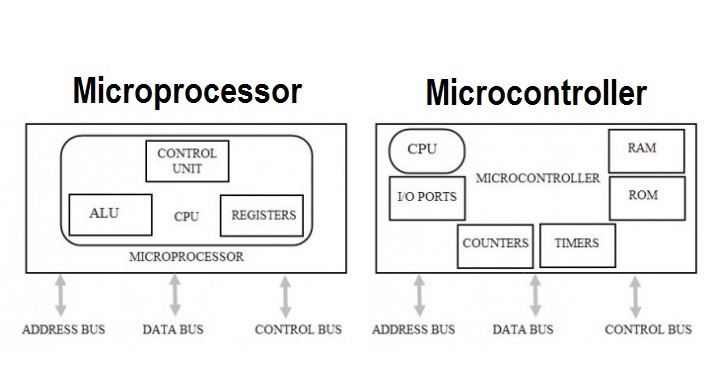The main difference between Microprocessor and Microcontroller is that a microprocessor is just an IC, modeled to run general digital computation aims. On the other hand, a microcontroller is an IC combined with different instruments to apply a particular application. Another considerable difference between a microprocessor and a microcontroller is that the main PCB size of a microprocessor basic system is too large, whereas, in the exploration of a microcontroller basic system, this PCB size is relatively small. We should determine the general structures of a Microprocessor and Microcontroller to understand them in detail, which is completely what we want to explore in this post.
What is the Difference between Microprocessors and Microcontrollers?
For non-professionals,
about electronics, it could always be hard and confusing to determine the difference between microprocessors and microcontrollers. While both microprocessors and microcontrollers are completely different from one another due to their hardware design and operation.
The major difference between a microprocessor and a microcontroller is that the IC of a Microprocessor just has a particular CPU inside it whereas the Microcontroller IC also has ROM, RAM, and other instruments attached to it. Some common examples of the microprocessor are AMD Athlon, Intel Core i7, Broadcom BCM2711, Raspberry Pi, etc., and some popular devices of microcontrollers are STM32, Arduino UNO, ATmega328, PIC16F877A, etc.
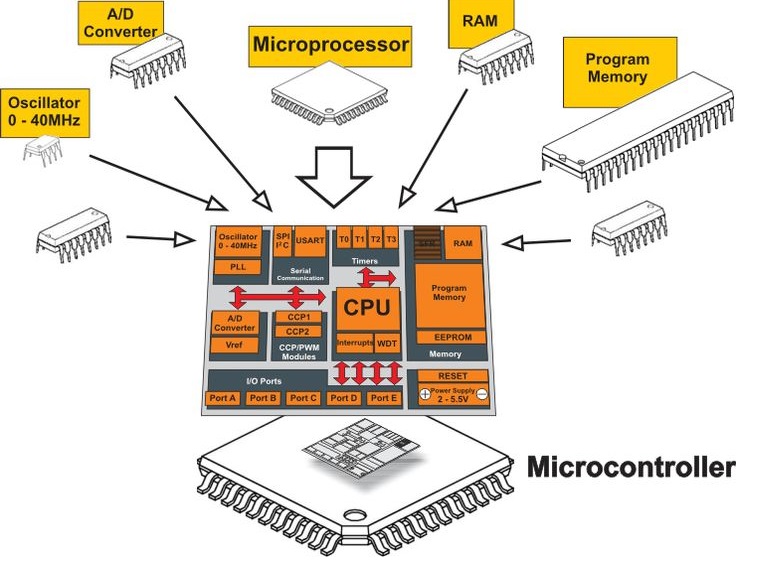
Choosing the appropriate option based on your particular design can be problematic. The need to have the best balance between performance, price, and power consumption has different key factors. First, there will be the development technology tips for the model you should focus on. However, when the microprocessor (MPU) or the microcontroller (MCU), becomes the foundation of the system approach, your final decision may have long-lasting effects. As a result, knowing the difference between microprocessors and microcontrollers becomes a considerable subject at this step. Before we start to present these differences, we provide a brief discussion about what a microcontroller and a microprocessor are.
What is a Microcontroller?
A microcontroller is like a simple computer designed on a single IC. It includes CU, ALU, ROM, timer, processor core, RAM, I/O connectors, register, and counters modeled to run several tasks. Microcontrollers are normally employed in applications and projects that need direct monitoring by users. Because it contains all the parts required in its simple chip, it does not require any additional sections to apply its task.
As a result, microcontrollers are commonly used in fixed systems and the main companies of manufacturing microcontrollers are using them in embedded applications. The microcontroller can be introduced as the center of an embedded circuit. Some common examples of popular and economic systems are AVR and 8051 series form.
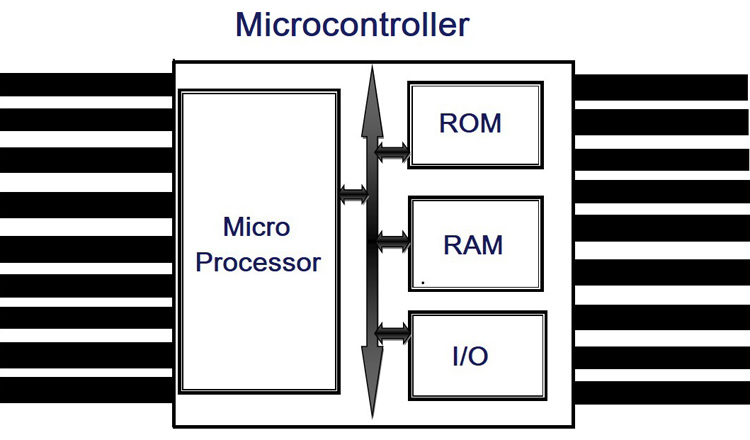
The tasks required to be run are provided inside the memory section (EPROM/EEPROM) through the microcontroller itself. However, a microcontroller system may use additional memory when the primary memory operates insufficiently to recover the programs or data.
When the requirement for a program operation is identified by the system, the PC generates the address of the suitable instruction which has to be produced. The internal biases of the circuit can send the data when control signals are produced by the CU. After analyzing, the decoding section recovers the instruction and the ALU operates that. The microcontrollers are categorized based on the size of data run in one simple cycle.
As we discussed before, a microcontroller has determined the memory section inside it which keeps the special code or data over which the circuit has to run. This is the main reason why MCUs are specified to be modeled to apply particularly for a particular system. Because it is generally not suitable to modify the data stored in the memory section inside the microcontroller for particular purpose aims.
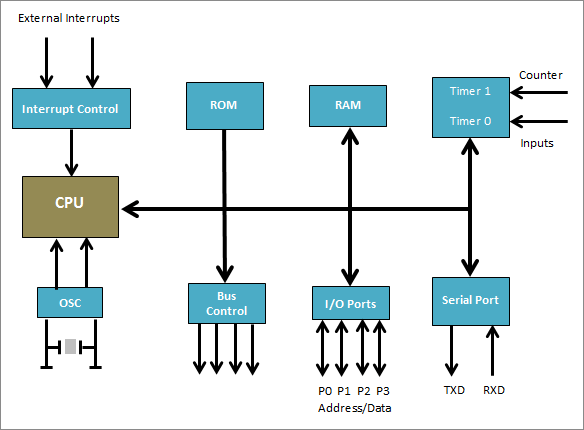
The above figure is the block diagram of the 8051 microcontrollers. All the required parts for a small project are supplied in a single chip. With the improvements in electronic technologies, several modern microcontrollers are being designed in the market. If you are encouraged to explore how to choose the best microcontroller for your program, visit this link.
What is a Microprocessor?
A microprocessor is just a CPU combined with one or multiple Integrated Circuits (ICs). It has not any ROM, RAM, and other instruments. The main operation center of a microprocessor contains registers, ALU, and a control unit. Microprocessors are categorized based on the data size in which ALU applies.
The performance of a microprocessor is based on additional circuits of peripherals to run. Microprocessors are not designed for multiple tasks but they are used where tasks are tricky and complex such as games running, improvement of software, and other programs that need high capacity for memory and where input and output are mixed. It may be introduced as the heart of a computer circuit. Some common examples of microprocessors are I3, I5, and Pentium.
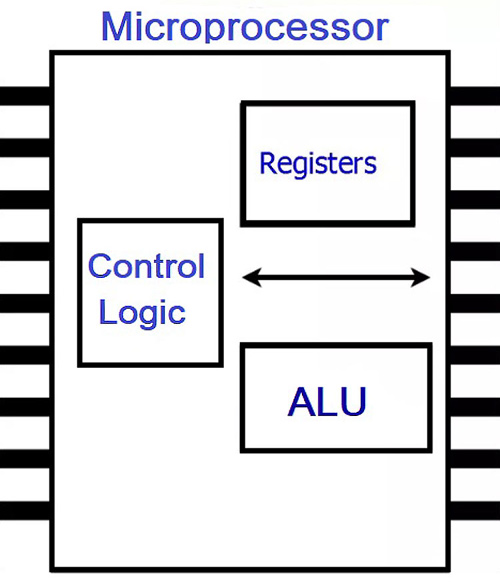
If the ALU section of the microprocessor is performing on 8-bit data in one simple cycle, it will be introduced as an 8-bit microprocessor. Likewise, if the ALU is working on 16-bit data, then it is a 16-bit system.
A microprocessor can run logical and arithmetic operations. The set of instructions that should be operated by a microprocessor is stored in a memory center. They are presented in an external place to the microprocessor. The applications which are needed to be run are stored by the designer in the memory system.
Fundamentally, the operation of any instruction within the processor contains three cycles. At first, the data is received, then it is recovered and finally, it is operated based on the decoded instruction. The data or code is sent with the bias system when the suitable monitoring signals are produced by the CU. Therefore, the ALU can run a specific operation.
As a result, we say the processor operates the particular application but the instruction data which is found by it, is stored in an additional chip or external memory. Thus, we say that a microprocessor is a single chip modeled for general computational applications.
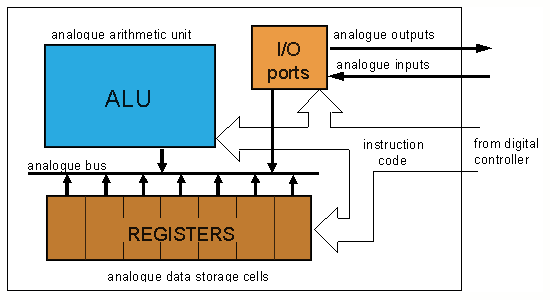
It can be easily seen from the figure diagram of a microprocessor that it has some registers and an ALU unit for processing and it does not require any RAM or ROM for it.
Microcontroller vs. Microprocessor: Primary Differences
A Microcontroller generally uses an on-chip-covered Flash memory to save and operate its application. Saving the data in this method means the microcontroller has fewer start-up times and operates the code immediately. The only actual limitation to utilizing the covered memory is that the total accessible memory space is restricted. Most Flash MCU instruments present on the market include a maximum of 2 Mbytes of memory for the program. This may cause a negative factor, based on the special application.
On the other hand, microprocessors have no particular memory in the same method. They employ external memory to supply programs and data saving. The data is normally saved in a non-volatile section, such as Serial Flash or NAND. At the start step, this is programmed into an external particular RAM and operation instructions. This means the MPU will not be quick and running as immediately as the microcontroller, but the value of RAM you can combine with the system is in the large range of hundreds of Gbytes for the NAND process.
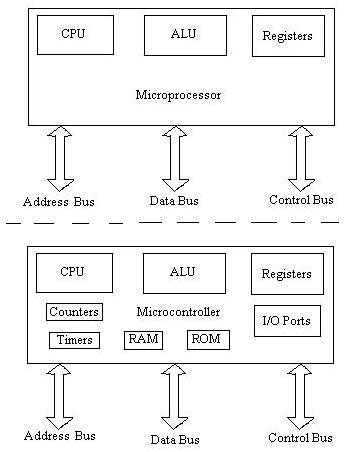
Another primary difference is the power source. By adding its own power source, an MCU requires only one simple voltage power center. In comparison, the microprocessor needs multiple different voltage centers for DDR, core, etc.
Difference Between Microprocessor and Microcontroller: Application Perspective
Some aspects of the modeling features can influence the choice of device in particular methods in the case of application perspective. For instance, is the value of peripheral covered channels needed more than can be extracted by an MCU? Or, does the marketing feature encourage a user to choose a capability that will not be feasible with the microcontroller because it does not include enough memory on-chip or has the necessary space?
There may be multiple product variations when working on the first structure and understanding that. In that case, it is very feasible a platform-based model approach will be selected. This can increase the requirement for Headroom Center to process power and rise the capabilities to improve future upgrades for the system.
Some Measurement Parameters
An approach that is problematic to detect is the needed operating procedure any given model might require. Supplying power detected based on the Dhrystone MIPS (DMIPS), can help to explore this aspect. The next table explains the difference between microprocessors and microcontrollers based on some measurement parameters.
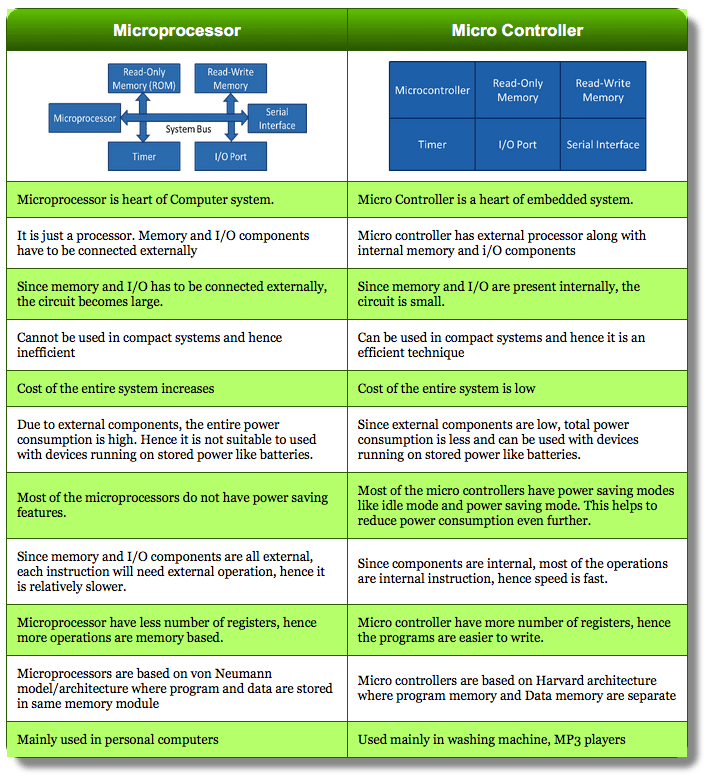
For instance, an ARM Cortex-M4-based MCU like Atmel’s SAM4 MCU (or the T-type Thermocouple Processor) is evaluated at close to 150 DMIPS. While an ARM Cortex-A4 data processor (MPU) such as Atmel’s SAMA4D3 can be close to 750 DMIPS. One way of calculating the DMIPS needed is by looking at the operating sections of the program.
Running a complete working system, including Android, Linux, or Windows CE, for your program may require at least 200–300 DMIPS. For many programs, a particular RTOS (Real-Time Operating System) can supply the rate of 50 DMIPS which is too adequate for them. Employing the RTOS also solves the problem of small memory space. However, a full working system needs a memory monitoring unit or MMU to operate appropriately which requires specifying the format of the processor center to be utilized and needs more processor ability for running.
Difference Between Microprocessor and Microcontroller: Common Applications
For running applications that need more number-operating great enough, DMIPS permitting requires to be presented on the working system, control tasks, and other communication. The more numeric the base of the application, the more possible the microprocessor is needed.
The user application may have a considerable aspect of the aim of the system. So, we should become familiar as consumers with employing intuitive and colorful graphical UIs (User Interfaces). Industrial applications are greatly utilizing this way of interaction. The working surrounding, while, can restrict the benefit of this one.
Why are the Differences Necessary?
At first, is the procedure overhead needed? An extra overhead of 90–100 DMIPS might demand a UI system such as Qt, because it is commonly utilized on Linux. The next factor is to operate with the complexity of the application. The Highest processing memory and power are required for more multimedia content, animations, effects, and more modifications operated to the displayed image. Finally, these requirements improve with the resolution and the MPU is more possible to use.
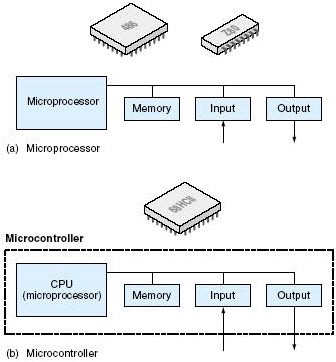
Otherwise, a simpler application with pseudo-static displays on a lower precision screen can be revised by the microcontroller. Another approach in favor of the microprocessor is that it is commonly equipped with a special TFT LCD monitor. Few numbers of MCUs have this ability. The TFT LCD monitor and some other driver sections should be joined externally.
Sampling a Microcontroller
As discussed before, some particular MCUs are now present in the market with TFT monitors. However, there should be adequately covered SRAM memory accessible to run the monitor. For instance, the QVGA with 320*240 size and 16-colour type needs 150 kB of SRAM to run and recover the display.
This is a high value of SRAM to provide approximately. Some additional memory would be needed, which may further join the BOM (Bill of Materials) and cover the gap with the MPU section. More advanced and complex usual UIs, especially employing displayers larger than 3.2 inches, may use an extra MPU. If MPUs are provided to run when it comes to operating a UI on the colorful TFT monitor, the MCUs are the centers for system or dot matrix of an LCD monitor with series interfaces.
Difference Between Microprocessor and Microcontroller: Connectivity Standpoint
From the aspect of connectivity standpoint, most MPU and MCU instruments are available, with all the usual peripheral applications. High-speed systems like Gigabit Ethernet ports, multiple 10/100 Ethernet ports, or HS USB 2.0 are typically only attached with MPU. They can process and handle large values of data. Whether there are adequate desirable channels and pathways to control the data traffic or not is a considerable question.
The effect of code space and stacks must be checked based on the relation protocols employed. Application required high-speed outputs especially about working system stacks will need an MPU basic model.
Another considerable issue to explore the difference between microprocessor and microcontroller selection is the requirement for a real-time feature of the system. According to the processor center employed in the MCU, the covered flash, and the software utilized between RTOS or metal C, the microcontroller will appropriately control the long-time precise applications.
Difference Between Microprocessor and Microcontroller: Power Consumption
The next step to notice is the consumption of power. While MPUs run with low power states, there are no adequate ones you can discover on the usual MCU. The MPU has an extra factor with the external hardware section to support it. So, adding an MPU into the low power state may be more difficult.
The practical consumption of the MPU is typically higher than the MCU. For Instance, you can set a constant between 10 to 100 with register factor and SRAM in a low power state. This is proportional to the value of RAM and the power needed by the running system to recover the operation continuously. The factors related to choosing either an MPU or MCU-based method are several and contain capability, performance, and cost.
Selecting One?
MCUs broadly can be used in economical solutions that need extreme monitoring of BOM and power preserving. High-performance programs use a large number of microprocessors functionally. Ultra-low power systems like smart meters, economic electronic devices, and remote controls where the model uses a high percentage of battery discover larger usage of microcontrollers.
They are also utilized where a highly particular behavior is required. MPUs are suitable for working systems in industrial and economic applications. These might be evaluated precisely and need several high-speed junctions.
Selecting the best option between MPU and MCU systems where you can simply set the optimized software provides the most perfect rate of return for the total system over time.
Key Differences Between Microprocessor and Microcontroller
- A microprocessor includes a register, ALU, and CU. While a microcontroller contains an I/O converter, RAM, DAC, or ADC.
- Microprocessors are too expensive compared to microcontrollers.
- A microprocessor includes a large number of information transfer tips in comparison with an MCU. This is due to the fact that the code or data in a microprocessor is sent between the microprocessor and additional memory. However, a microcontroller permits the transfer of data and code through it due to the presentation of the memory sensor.
- Because the microprocessor center only maintains the processing sections, it requires to be faced with other external chips to run the microcomputer-based instrument. Thus, its PCB has a big size. On the other hand, a microcontroller does not demand additional ICs for the system. Thus, its size is usually small.
- According to the presence of different ICs, a microprocessor device is comparatively bulky.
- The function speed of a microprocessor is close to 1 GHz. Whereas a microcontroller performs comparatively at a lower velocity of about 5 to 40 MHz.
- A microprocessor is modeled to operate in a digital system. On the other hand, a microcontroller is particularly made for complex systems.
- Microprocessors are less effective in comparison with microcontrollers.
- A microcontroller generally uses less power in comparison with an MCU.
The next comparison chart presents the difference between microprocessors and microcontrollers in summary.
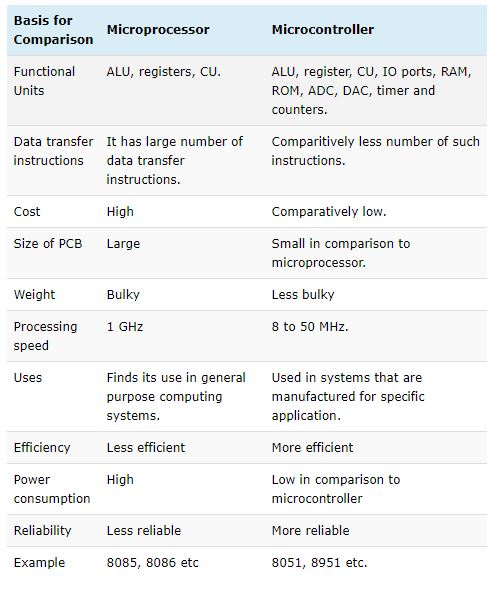
Conclusion
This post can help you with the complete comparison between microcontrollers and microprocessors. From the above explanation, we can generally say a microprocessor-based circuit is less reliable in comparison with a microcontroller-based device.
Buy Equipment or Ask for a Service
By using Linquip RFQ Service, you can expect to receive quotations from various suppliers across multiple industries and regions.
Click Here to Request a Quotation From Suppliers and Service Providers
Read More on Linquip
- Differences Between P-Type and N-Type Semiconductors
- Generator vs Inverter: What’s the Main Difference
- Difference Between Fuse and MCB: A Comprehensive Guide

